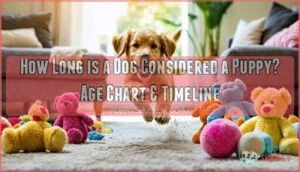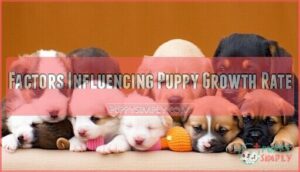This site is supported by our readers. We may earn a commission, at no cost to you, if you purchase through links.
 Blink and that fluffy bundle who learned to sit for a treat is suddenly tall enough to swipe leftovers off the counter. Puppyhood doesn’t follow the same script for every dog—tiny breeds seem to grow up overnight, while gangly giant breeds cling to their awkward phase for months on end.
Blink and that fluffy bundle who learned to sit for a treat is suddenly tall enough to swipe leftovers off the counter. Puppyhood doesn’t follow the same script for every dog—tiny breeds seem to grow up overnight, while gangly giant breeds cling to their awkward phase for months on end.
If you’ve ever wondered when a puppy outgrows that wild, hungry energy or when it’s time to swap their food and training routines, you’re not alone. Understanding how long a dog is considered a puppy shapes nearly every choice you make, from health checkups to the toys you leave on the floor.
Table Of Contents
- Key Takeaways
- How Long is a Dog Considered a Puppy?
- Puppy Development Stages by Age
- Breed Size and Puppy Maturity Timelines
- Physical and Emotional Maturity Signs
- Factors Influencing Puppy Growth Rate
- Puppy Nutrition and Dietary Needs
- Training and Socialization Milestones
- Monitoring Puppy Health and Development
- Transitioning From Puppy to Adult Care
- Frequently Asked Questions (FAQs)
- Conclusion
Key Takeaways
- Puppyhood typically lasts from birth to about 6 months but can extend up to 24 months for giant breeds.
- Breed size is the main factor that determines how quickly a puppy reaches physical and emotional maturity.
- Key milestones like socialization, teething, and growth plate closure occur on different timelines depending on the dog’s size and genetics.
- Transitioning from puppy care to adult routines depends on individual growth, with close attention to diet, training, and regular veterinary check-ups.
How Long is a Dog Considered a Puppy?
Most dog owners wonder when their furry friend will officially leave puppyhood behind. The answer isn’t as simple as picking a single birthday, because maturity happens in stages and varies by breed.
Let’s break down what veterinarians consider when they classify a dog as a puppy versus an adult.
Definition of Puppyhood
Puppyhood isn’t just about fuzzy ears and clumsy paws—it’s a distinct life stage marked by rapid physical growth, developmental milestones, and specific nutritional needs that set your dog up for a healthy adult life. Most veterinarians define puppyhood using these age parameters:
Puppyhood marks a vital stage of fast growth and unique needs that lay the foundation for a dog’s healthy adulthood
- Birth through 6–7 months represents the core puppy stages, aligning with critical vaccine schedules and socialization windows.
- 6–12 months covers the juvenile phase, when puberty and sexual maturity begin.
- Up to 24 months encompasses the full maturity spectrum, especially for larger breeds still completing their dog development.
Defining puppyhood depends on breed size, growth rate, and behavioral changes rather than a single fixed timeline.
Key Milestones of Puppy Development
Your puppy’s journey from newborn to adult happens in five distinct stages, each bringing new physical abilities, behavioral changes, and training opportunities.
The neonatal stage (0–2 weeks) transitions to sensory development at 2–4 weeks, when sight and hearing emerge. The socialization period (3–12 weeks) is critical for behavioral foundations.
The teething stage (3–6 months) overlaps with house-training milestones. Finally, sexual maturity and physical maturity arrive between 6–18 months, completing puppyhood.
Age Ranges by Veterinary Standards
Veterinarians use established life stage frameworks to define when puppyhood ends. According to the AAHA 2019 Canine Life Stage Guidelines, puppyhood officially spans birth to 6 months, marking the period of most intensive growth and vaccination schedules. However, your dog’s breed size creates significant variation—toy breeds may reach maturity by 9 months, while giant breeds can take up to 24 months.
That’s why individualized care and growth monitoring are important throughout your puppy’s development. Preventive care plans should be tailored to each dog’s individual needs.
Puppy Development Stages by Age
Your puppy’s journey from newborn to adult follows predictable stages, each bringing distinct physical and behavioral changes. Understanding these phases helps you provide the right care at the right time.
Here’s what to expect as your puppy grows through each developmental period.
Neonatal, Transitional, and Socialization Periods
The first few months of a dog’s life unfold in three distinct waves, each bringing dramatic changes that shape everything from how your puppy sees the world to how they’ll behave as an adult.
During the neonatal stage (0–2 weeks), puppies can’t see or hear yet, making early interaction important for sensory development. The transitional stage (2–4 weeks) brings working eyes and ears, plus the weaning process begins.
Then comes the critical period for socialization (3–12 weeks), when puppies develop social skills that’ll last a lifetime.
Juvenile and Adolescent Phases
Between 3 and 18 months, your pup enters what many owners call the "teenage years"—a stretch where growth spurts, hormonal shifts, and boundary-testing behavior all collide at once. The juvenile stage (3–6 months) kicks off with teething and housebreaking, while the adolescence period (6–18 months) brings puberty onset and real training challenges.
During dog adolescence, you’ll notice:
- Sexual maturity around 6–8 months, though emotional maturity lags behind
- Increased independence and occasional "selective hearing" during training
- Dietary adjustments needed to support ongoing physical development
Behavioral and Sensory Changes
As your dog matures from week to week, you’ll watch their senses sharpen and their personality unfold—changes that happen faster than you might expect. Sensory development peaks between 2 and 12 weeks, when hearing, vision, and smell fully activate. During this critical socialization window, your puppy’s brain forms lasting impressions about people, animals, and environments. Fear periods emerge around 8–11 weeks and again during adolescence, affecting behavioral milestones. Cognitive changes continue through the first year as neural pathways strengthen with each new experience.
| Age Range | Key Behavioral and Sensory Changes |
|---|---|
| 0–2 weeks | Limited sensory function; relies on touch and warmth |
| 2–4 weeks | Eyes and ears open; begins responding to sounds and movement |
| 3–12 weeks | Critical socialization period; rapid cognitive development and fear imprinting |
| 3–6 months | Teething behavior; testing boundaries and learning impulse control |
| 6–18 months | Hormonal shifts; increased independence and selective responsiveness |
Breed Size and Puppy Maturity Timelines
Not all puppies grow up at the same pace, and breed size plays a huge role in how quickly your pup reaches adulthood. A Chihuahua will be fully grown long before a Great Dane even comes close.
Here’s how different breed sizes stack up with respect to leaving puppyhood behind.
Toy and Small Breed Maturity
If you’ve got a Chihuahua or a Pomeranian, you won’t be waiting two years to meet your adult dog—toy and small breeds hit maturity much faster than their larger cousins. Here’s what to expect during puppy development stages:
- Toy breed puppies reach adult size by 6–9 months, finishing growth spurts early
- Small breeds usually mature around 9–12 months, when growth plates seal
- Teething timeline wraps up earlier, reducing training challenges sooner
- Socialization needs remain critical during these condensed developmental windows
Your small pup transitions to dog maturity faster, but don’t skip proper socialization—these formative months shape lifelong behavior.
Medium, Large, and Giant Breed Differences
Medium breeds reach physical maturity around 8–12 months, when growth plates close and adult size arrives. Large breeds need 12–18 months, while giant breeds like Great Danes take a full 18–24 months to finish growing. That extended maturity timeline means bigger dogs show puppy behaviors longer—your Mastiff might act goofy until two years old.
Dietary needs differ too, since rapid growth in large and giant breeds requires careful nutrition to protect developing joints and bones. These breeds benefit from glucosamine and chondroitin supplementation to support joint health.
Breed-Specific Development Charts
Your Chihuahua won’t follow the same growth roadmap as your neighbor’s Newfoundland—that’s where breed-specific development charts come in handy. These charts map growth stages according to size classifications, helping you interpret what’s normal for your dog breed.
Genetic predisposition drives breed variance, creating significant growth disparities:
- Toy breeds finish development at 6–9 months
- Medium breeds reach breed maturity around 12–15 months
- Giant breeds need up to 24 months for complete dog growth stages
Understanding breed-specific development stages helps you adjust care appropriately.
Physical and Emotional Maturity Signs
Your puppy’s journey to adulthood isn’t just about getting bigger. Physical changes happen alongside shifts in behavior and temperament, and knowing what to watch for helps you understand where your dog is in their development.
Here are the key signs that show your puppy is becoming an adult dog.
Physical Growth and Growth Plate Closure
Understanding when your puppy stops growing isn’t just about watching them get bigger—it’s about knowing when those critical growth plates finally seal shut. These plates are soft cartilage zones at bone ends that harden during skeletal development. Small breeds usually see closure by 9–12 months, while giant breeds can take 18–24 months.
Growth spurts happen unevenly, so proper nutrition directly impacts healthy bone formation and physical maturity timing across all dog growth stages.
Emotional and Behavioral Maturity Indicators
One day your playful puppy suddenly waits for instructions instead of leaping into mischief—that’s impulse control growing in. Emotional maturity also shows up as steadier fear responses, improved social skills with dogs and people, and new independence signs.
As trainability changes, your adolescent dog behavior softens, letting you spot subtle shifts in puppy behavior and dog emotional development along the way.
Sexual Maturity Vs. Adult Behavior
Just when you think your young pup is finally figuring things out, along comes sexual maturity—and suddenly, emotional growth and physical changes don’t always follow the same timeline.
- Hormonal Impact can trigger sudden Behavioral Changes and Training Regression.
- Social Dynamics shift—your puppy may act bolder or more cautious.
- Maturity Disconnect appears, where sexual maturity outpaces emotional stability.
Factors Influencing Puppy Growth Rate
Several key factors play a role in how quickly your puppy grows up. From genetics to nutrition, each one shapes their journey from puppyhood to adulthood.
Here’s what can affect how fast your dog matures.
Genetics and Breed Characteristics
From big paws to tiny snouts, a puppy’s genes shape how fast they grow, when they hit milestones, and even how long they stay in their playful stage. Breed characteristics—like size, coat, and temperament traits—are set by breed standards and driven by heritability factors.
Some breeds mature early, while others, due to genetic health and breed predispositions, take their time.
Biological Sex Differences
Along with a puppy’s breed and genetics, whether you have a boy or girl dog can make a real difference in how quickly they grow up and settle into their adult personalities.
Growth Variation and Hormonal Influence lead to differences in Size Dimorphism and Maturity Onset. Male dogs often grow larger and mature a bit slower, while female dogs may show earlier behavioral tendencies of adulthood.
Health and Nutrition Impacts
When a puppy’s nutrition falls short—think Dietary Deficiencies or the wrong dog diet—it doesn’t just slow growth but can cause long-term trouble, from delayed Growth Plate closure to Joint Health issues and a shaky Gut Microbiome.
Proper puppy food fuels bones, brains, and balance, while too much or too little puts a growing pup at risk for Obesity Risks or stunted development.
Puppy Nutrition and Dietary Needs
Making sure your puppy gets the right nutrition sets the stage for healthy growth and development. What and how you feed your puppy changes as they get older and bigger. Here’s what you need to know about their diet at every step.
Nutritional Requirements for Growth
Ever wonder why puppies seem to eat with unstoppable enthusiasm? Their bodies are working overtime, building muscle and bone faster than you might expect.
That’s where higher Protein Requirements, careful Calcium Balance, and specialized Breed Formulas in puppy food come in. Frequent meals help meet the unique nutritional needs of puppies, supporting healthy Growth Plates during this critical stage of puppy growth and development.
When to Switch to Adult Dog Food
As your dog’s first birthday inches closer, you might start wondering if it’s finally time to trade in those puppy kibbles for an adult recipe. Growth plate closure, changes in activity level, and weight management are key signals.
Watch for dietary shift signs—slower growth or less interest in puppy food often mean your dog’s ready for a gradual shift to adult food.
Breed-Specific Puppy Diets
Not all puppies can thrive on the same menu—what fuels a tiny Yorkie may leave a Great Dane puppy coming up short. Breed size, growth rate, and unique feeding schedules shape the nutritional needs of puppies. Try to match your pup’s diet to their specific:
- Breed size
- Dietary needs
- Growth rate
- Food types
- Breed-specific development stages
Training and Socialization Milestones
From the day you bring your puppy home, training and social skills are a big part of their growth. There are a few key milestones to watch for as your dog gets older. Here’s what to expect along the way.
Early Training and Housebreaking
Getting ahead with early training and housebreaking is a lot like planting seeds—you’ll see the best results when you start the right habits from day one. Crate training builds security, while a steady potty schedule helps your pup learn faster.
Working on leash manners and bite inhibition sets clear boundaries, making those early puppy training milestones feel so much easier.
Socialization Windows
Did you know there’s a short stretch in your puppy’s early life when meeting new faces and exploring the world can shape their confidence for years to come? This Critical Period is the ideal time for dog socialization—helping develop social skills, reduce fear responses, and adapt to new environments.
Breed differences mean each puppy’s journey through puppyhood looks a little different.
Transitioning Training for Adolescents
During the puppy adolescence period, expect some dog adolescence behavior—think testing boundaries and sudden selective hearing. Reinforcement strategies, like rewarding patience or good leash manners, become essential.
Continued socialization stays important, too, even as your pup seems bolder. Adolescent challenges need patience and consistency; focus on impulse control so the lessons you’ve worked so hard on during dog training really stick.
Monitoring Puppy Health and Development
Keeping up with your puppy’s health means paying attention to a few key areas as they grow. There are important routines and changes to watch for along the way.
Here’s what you’ll want to focus on during these early months.
Veterinary Check-Up Schedules
Just like kids heading in for their school check-ups, your young dog needs regular trips to the vet to make sure they’re growing strong and healthy. Here’s what to expect at each visit:
- Vaccination Timelines review
- Deworming Protocols
- Growth Monitoring
- Behavioral Assessments
- Preventative Care planning
Consistent veterinary checkups build lifelong puppy health.
Vaccinations and Preventive Care
After each wellness exam, your veterinarian maps out upcoming puppy vaccinations, double-checks the deworming schedule, and answers those burning questions about parasite prevention. Core vaccines, like parvo and distemper, protect when your puppy is most at risk.
Keeping up with preventive care, plus early dental care, shields your puppy’s health through this fast-paced stage of puppy development and beyond.
Tracking Growth and Behavioral Changes
Some days, growth spurts seem to happen overnight. You might catch glimpses of behavioral regression, like sudden chewing or accidents, even as cognitive development leaps forward.
Socialization setbacks can pop up unexpectedly, reminding you the puppy aging process isn’t always linear. Track these milestones for a clearer picture of your dog’s growth and maturity along your puppy development timeline.
Transitioning From Puppy to Adult Care
As your puppy starts growing up, their needs begin to shift in small but important ways. Keeping up with these changes helps make sure they stay healthy and happy.
Here’s what to keep in mind as you move from puppy care to a routine made for adult dogs.
Adjusting Exercise and Activity Levels
Finding the right balance between playtime and rest can feel a bit like steering a boat—too much of one, and you might find yourself off course as your growing companion’s needs begin to shift.
As your puppy matures, adjust dog exercise routines based on changing energy levels, breed demands, and age adjustments. Watch for overtraining signs and vary exercise types to suit development.
Updating Diet and Portion Sizes
When mealtime rolls around and your dog starts eyeing the kibble bowl with all the hope in the world, figuring out what and how much to feed can feel a bit like solving a moving puzzle. Calorie needs shift with growth spurts, so check food labels, watch portion control, and practice weight monitoring.
Adjust diet shifts gradually from puppy food to adult dog food for steady nutrition.
Supporting Ongoing Behavioral Development
Even after your pup leaves those playful early months behind, their behavior keeps changing in small but important ways. To help your dog thrive, focus on:
- Consistent training routines using Positive Reinforcement
- Addressing Behavioral Setbacks and Adolescent Challenges with patience
- Regular Enrichment Activities for continued dog socialization
Puppyhood sets the foundation, but your guidance shapes lifelong behavior.
Frequently Asked Questions (FAQs)
What signs indicate my dog is teething?
They say, “a watched pot never boils,” and teething feels just as slow for your puppy.
Look for excessive chewing, drooling signs, red gums, mild puppy discomfort, and loose puppy teeth—markers within the teething timeline of puppy development stages.
How can I calm an overly energetic puppy?
Start by meeting exercise needs—daily walks or play go a long way.
Use calming techniques, like chew toys and puzzle feeders, to provide mental stimulation.
Consistent training methods help manage dog energy levels, regardless of breed tendencies or dog behavior changes.
When should I start grooming my puppy?
If your floors start looking hairier than a wool sweater in a dust storm, it’s time for that first grooming.
Depending on breed differences and puppy sensitivity, introduce gentle grooming tools early, possibly before your puppyhood whirlwind hits full speed.
Can puppies safely interact with older dogs?
Close supervision levels are essential when a puppy meets older dogs. Focus on safe introductions and temperament matching.
Dog socialization encourages bite inhibition, while monitoring for resource guarding provides a healthy foundation during puppyhood and later development stages.
Are there early signs of developmental issues?
Picture a puppy still lagging while the littermates zoom past milestones—now, that should raise your eyebrows. Signs like Growth Stunting, Social Issues, Behavioral Red Flags, or Cognitive Deficits in puppy development stages deserve a vet’s attention.
Conclusion
Worried you’ll miss the right moment to treat your pup like a grown dog? You’re not alone—every owner wonders exactly how long a dog is considered a puppy. While the finish line isn’t stamped on their wagging tail, it’s marked by milestones in growth, maturity, and behavior.
Only you, observing each leap and setback, will notice when puppyhood finally fades. Let those signs guide you. After all, growing up is a journey both of you share.
- https://pmc.ncbi.nlm.nih.gov/articles/PMC8110720/
- https://www.spotandtango.com/blog/puppy-growth-chart
- https://www.azhumane.org/wp-content/uploads/Developmental-Stages-of-a-Dog-1.pdf
- https://www.pawschicago.org/news-resources/all-about-dogs/how-dogs-age
- https://www.whole-dog-journal.com/puppies/how-long-is-a-dog-considered-a-puppy/
















